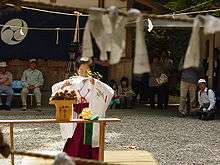Indigenous religion
Indigenous religions is a category used in the study of religion to demarcate the religious belief systems of communities described as being "indigenous". This category is often juxtaposed against others such as the "world religions" and "new religious movements". The term is commonly applied to a range of different belief systems across the Americas, Australasia, Asia, Africa, and Northern Europe, particularly to those practiced by communities living under the impact of colonialism.
The term "indigenous religions" is usually applied to the localised belief systems of small-scale societies. These belief systems do not typically engage in proselytization, thus distinguishing them from movements like Christianity, Islam, and Buddhism that all seek converts and which are typically classified as "world religions". They are also often characterised as being distinct from the "world religions" because they are orally transmitted, intertwined with traditional lifestyles, and pluralist. Numerically, the majority of the world's religions could be classed as "indigenous", although the number of "indigenous religionists" is significantly smaller than the number of individuals who practice one of the "world religions".
Within the study of religion there has been much debate as to what the scope of the category should be, largely arising from debates over what the term "indigenous" should best encompass. For instance, the Japanese religion of Shinto is often referred to as an "indigenous religion" although, because the Japanese are not a colonised society but have colonised neighbouring societies like that of the Ainu, there is debate as to whether they meet the definition of "indigenous". In some cases, practitioners of new religions like Heathenry have sought to present theirs as "indigenous religions" although have faced scepticism from scholars of religion.
Definition
The academic study of religions has used three concepts through which to categorise different religious groups: "world religions", "new religious movements", and "indigenous religions".[1] The scholar of religion Carole M. Cusack noted that "indigenous religions" were rejected from the "world religions" category because they "are typically this-wordly, orally transmitted, non-proselytizing, folk-oriented, expressed in myths and traditional law, and pluralist."[2]
According to the scholar of religion Graham Harvey, indigenous religions constitute the majority of the world's religions.[3] At the same time, he noted that "indigenous religionists" do not numerically make up the majority of religious people.[3]
Some indigenous religions have gained as much global visibility as some of the "world religions".[4] For instance, musicians influenced by the belief systems of the Maori, Indigenous Australian, and Canadian First Nations peoples have had their work exposed to an international audience.[4]
Examples

The Japanese religion Shinto is often described as an "indigenous religion", although the scholar of Asian studies John K. Nelson noted that it is often left "unclear" as to what is meant by the term "indigenous" in this context.[5] He noted, for example, that there remain debates as to when the ancestors of the Japanese arrived in the islands that now make up Japan and that there were other communities, such as the Ainu, who lived on some of these islands before them.[5]
Many followers of Heathenry, a modern Pagan religion that scholars recognise as a new religious movement, like to regard their belief system as an "indigenous religion".[6] In claiming a sense of indigeneity, some Heathens—particularly in the United States—attempt to frame themselves as the successors to the pre-Christian belief systems of linguistic Germanic communities in Northern Europe and thus victims of Medieval Christian colonialism and imperialism. The scholars Jenifer Snook, Thad Horrell, and Kirsten Horton argued that in doing so, these Heathens ignore the fact that most of them are white, and thus members of the same ethnic community which has perpetrated and benefitted from colonial and imperial policies against indigenous communities in the Americas and elsewhere.[7]
See also
Sources
Footnotes
- Harvey 2000, p. 6.
- Cusack 2016, p. 154.
- Harvey 2000, p. 3.
- Harvey 2000, p. 4.
- Nelson 1996, p. 7.
- Snook 2015, p. 145; Gregorius 2015, p. 74.
- Snook, Horrell & Horton 2017, p. 58.
Bibliography
- Cusack, Carole M. (2016). "Archaeology and the World Religions Paradigm: The European Neolithic, Religion and Cultural Imperialism". In Christopher R. Cotter; David G. Robertson (eds.). After World Religions: Reconstructing Religious Studies. London and New York: Routledge. pp. 153–67. ISBN 978-1-138-91912-9.CS1 maint: ref=harv (link)
- Gregorius, Fredrik (2015). "Modern Heathenism in Sweden: A Case Study in the Creation of a Traditional Religion". In Rountree, Kathryn (ed.). Contemporary Pagan and Native Faith Movements in Europe: Colonialist and Nationalist Impulses. New York and Oxford: Berghahn. pp. 64–85. ISBN 978-1-78238-646-9.CS1 maint: ref=harv (link)
- Harvey, Graham (2000). "Introduction". In Graham Harvey (ed.). Indigenous Religions: A Companion. London and New York: Cassell. pp. 1–19. ISBN 978-0304704484.CS1 maint: ref=harv (link)
- Nelson, John K. (1996). A Year in the Life of a Shinto Shrine. Seattle and London: University of Washington Press. ISBN 978-0295975009.CS1 maint: ref=harv (link)
- Snook, Jennifer (2015). American Heathens: The Politics of Identity in a Pagan Religious Movement. Philadelphia: Temple University Press. ISBN 978-1-4399-1097-9.CS1 maint: ref=harv (link)
- Snook, Jennifer; Horrell, Thad; Horton, Kristen (2017). "Heathens in the United States: The Return to "Tribes" in the Construction of a Peoplehood". In Rountree, Kathryn (ed.). Cosmopolitanism, Nationalism, and Modern Paganism. New York: Palgrave Macmillan. pp. 43–64. ISBN 978-1-137-57040-6.CS1 maint: ref=harv (link)